Haiyantang
The Haiyantang (Chinese: 海晏堂; pinyin: Hǎiyàntáng) was an area in the Xiyang Lou (Western style mansions) of the Old Summer Palace, which included the famous Zodiac Fountain - water clock fountain consisting of 12 bronze Chinese zodiac statues. Supposedly designed by Giuseppe Castiglione for the Qianlong Emperor, the statues would spout out water from their mouths to tell the time.[1][2]
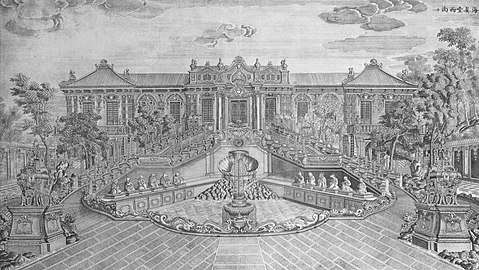
The bronze-cast heads of the stone statues were among the treasures looted during the destruction of the Old Summer Palace by British and French expeditionary forces in 1860 during the Second Opium War.[3] Since then, they have been among the most visible examples of attempts to repatriate Chinese art and cultural artifacts. About the scandal with two of this heads see 2009 auction of Old Summer Palace bronze heads.
Current status
| Photo | Animal | Year recovered | Current location | Cost | Notes |
|---|---|---|---|---|---|
 |
Rat | 2013 | National Museum of China[4] | $18 million at hammer price | Yves Saint Laurent's collection. Christie's, 2009.
Donated by François Pinault (Christie's owner) in a ceremony on June 28, 2013[4] |
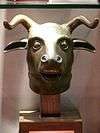 |
Ox | 2000 | Poly Art Museum, Beijing | USD $0,98 million | Sotheby's London, June 1989.
By Christie's Hong Kong, 2000[5]. From China Poly Group Corp. |
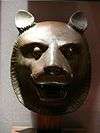 |
Tiger | 2000 | Poly Art Museum, Beijing | USD $1,98 million | Sotheby's London, June 1989.
By Sotheby's Hong Kong, 2000[5]. From China Poly Group Corp. |
| Rabbit | 2013 | National Museum of China[4] | $18 million at hammer price | Yves Saint Laurent's collection. Christie's, 2009
Donated by François Pinault in a ceremony on June 28, 2013[4] | |
| Dragon | - | - | - | - | |
| Snake | - | - | - | - | |
 |
Horse | 2007 | Capital Museum[6] | US$8.9 million | Sotheby's London, June 1989, 400,000 USD.
From Stanley Ho, by Sotheby's Hong Kong |
| Goat | - | - | - | - | |
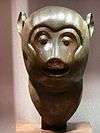 |
Monkey | 2000 | Poly Art Museum, Beijing | US$1.03 million | New York, 1987.
By Christie's Hong Kong, 2000[5] From China Poly Group Corp. |
| Rooster | - | - | - | - | |
| Dog | - | - | - | In 2003 a Hong Kong auction house planned to sell the fake[6] | |
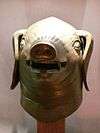 |
Pig | 2003 | Poly Art Museum, Beijing[6] | US$0.77 million | New York, 1987[5].
From Stanley Ho[6] |
In culture
- Ai Weiwei in 2010 created his own interpretation of 12 heads "The Circle of Animals/Zodiac Heads", where 5 were recreated[7]. It exists in bronze and gold versions[8]. Sold for 4.4 million.[9]
- CZ12 (2012) - Jackie Chan's movie about treasure hunting.
See also
- 2009 auction of Old Summer Palace bronze heads
- State Administration of Cultural Heritage
References
- CSmonitor.com. "CSmonitor.com." China protests Christie's auction in Paris of relics. Retrieved on 2009-02-20.
- BBC News: Chinese zodiac statues' origins
- Wtop.com. "Wtop.com." French judges allows auction of Chinese artifacts. Retrieved on 2009-02-20.
- "Looted Bronzes Return To China: Animal Heads Were Taken From Beijing Palace In 1860". Huffington Post. June 28, 2013. Retrieved June 30, 2013.
- Peter Hays Gries, Stanley Rosen. State and Society in 21st Century China: Crisis, Contention and Legitimation
- Li, Lillian (2012). "Relics & Controversy: The Controversy Surrounding the 12 Zodiac Animal Heads". The Garden of Perfect Brightness III: Destruction, Looting, and Memory (1860-Present). Massachusetts Institute of Technology. Retrieved 2012-11-10.
- Telegraph. The meaning of Ai Weiwei's 12 Zodiac Heads
- Ai Weiwei’s Zodiac Heads Hit $4.4 Million at $26.9 Million Phillips London Contemporary Art Evening Sale // ArtNet
External links
| Wikimedia Commons has media related to Beast head statue of the Old Summer Palace. |
- International Herald Tribute, Auction Houses Add Insult to Injury, May 6, 2000
- Press Release: Bronze animals heads from Summer Palace go on display, Hong Kong, Heritage Museum Friday, January 9, 2004
- Macao casino mogul Stanley Ho buys stolen Chinese relic for US$8.9 million 21 September, 2007
- BBC report of February 2009 auction {rat & rabbit}
- BBC report/photographs of 4 of 5 bronze heads recovered prior to 2009 auction {OX, Tiger. Monkey, Pig}
- report/photograph of the Haiyantang Horse head statute